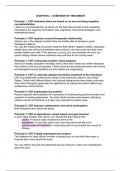Summary
Short summary of Beck's 'Cognitive Behavioral Therapy' book for the CBT course
- Course
- Institution
- Book
This document contains a short summary per chapter of all the chapters we had to learn for the CBT course, based on the book of Beck. I got a 9.9 for my exam! Beware: It does not contain the first chapter since I did not find any useful information for the exam in that chapter. Furthermore, this...
[Show more]




